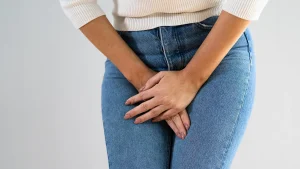“Women still hear regularly that this is something they have to learn to live with. But that’s not true. It would be a great job for other healthcare providers to point out that there is a good chance that it will go away temporarily after giving birth. Then it keeps the conversation open and women are encouraged to be open as well.”
age
While it is often thought that older people in particular suffer from urinary incontinence, it is also a well-known problem in children (young people). “I see children passing on a regular basis. This is usually related to urge incontinence, but stress incontinence also occurs, for example, when children cannot hold in urine because of laughter. The taboos are harsh there, but the teenager eventually dares to tell his mother or father.” Then they are taken to the doctor: “It’s something that suits all ages, but it increases with age,” says Comeling.
“The biggest risk comes from pregnancy and childbirth, but it also depends on what your DNA package is like. If you have strong supportive tissue, you’re better off than the other person. If you’re someone who easily develops vaginal prolapse, there’s also a greater chance of developing urinary incontinence.” Weight plays a role, but it could be anything.

impact
In the consulting room, Comeling sees that most women wait a long time before going to the doctor. “After successful treatment, we often hear: ‘I should have done this ten years ago.’ We think that’s a great shame.” Women also often hear from health care providers that “it’s part of it.” “That’s not the case. It’s definitely not part of it. At the same time, we cannot always solve the problem completely, but we can improve it. Women should not continue to walk around with it, but should go to the doctor.
The urologist hears stories that women drink too little (water) to prevent bladder emptying. This does not help, Kumeling asserts. “Reducing fluids can make it worse, because you get concentrated urine. This irritates the bladder mucosa more than the urine that normally forms. You’ve already lost half a liter of fluid by inhaling and exhaling. If you drink a little, it can They get constipation and headache. Women also go to the toilet all day to prevent urine leakage but with a leaky faucet, this makes no sense.
Urinary incontinence can have a significant impact on your life. “If it’s serious, they just have to get out of their chair and it will go down their legs. Some women lose a pint to a liter of urine a day. After treatment they realize that their whole life has revolved around the fear of someone else seeing it or smelling it. People focus their lives “It’s all on him and they can become socially isolated. It’s very bad.”
exercises
Comling explains what women can do with stress incontinence. “If you have stress incontinence, look online for pelvic floor muscle exercises. Women are free to try these on their own. You can start these exercises during pregnancy or after giving birth. Not all women need to go to the doctor, and the exercises can really help.”
“If it doesn’t work enough and you feel discomfort, take the step to see a pelvic physiotherapist. It may also be the case that your pelvic muscles are too tense, and these exercises will actually make things worse. A pelvic physiotherapist can help In doing the right exercises.

practical
If the complaints are not resolved by pelvic floor muscle exercises, multiple treatments are possible. The most common treatment is the placement of a so-called “tape”. “We place a support belt under the urethra using plastic or our own material from the tendon sheet of the abdominal muscle. The urethra closes on the belt when pressure is applied. This has a good result for 90 percent of women.
If that doesn’t work or you see that your urethra isn’t going down, the problem is with the sphincter muscle, explains Comling. “Then it can be treated with bulk injections, which are either fillers or a non-dissolving gel. This is injected around the urethra. From the outside it compresses the urethra for support. To treat urge incontinence, Botox can be injected into the bladder wall. The bladder is then partially paralyzed and can’t squeeze right away when the urge signal comes. This has helped 80 percent of women. Nerve stimulation or medication can also help.”
Kringsperproteus
Recently, it has also become possible to obtain a sphincter prosthesis. This has been happening abroad for a much longer time. We only perform this procedure in two centers in the Netherlands. The Netherlands is really lagging behind when it comes to treating severe stress urinary incontinence. Unknown means unlovable, I guess. “Not everyone knows what it is.”
The prosthesis is more than a band. “First we try the belt. We want to apply the artificial sphincter if the woman continues to complain of urinary incontinence despite previous treatment. For younger women, another alternative will be considered first to avoid having to put the artificial sphincter in as often. On average, a part or the entire system needs to be replaced every ten or fifteen years. For example, we want to start this as late as possible for a woman of 40 years.
“The intervention is successful. There is a 60 to 100 percent chance of improvement, so it is an important possibility. I hope that in five years we will not only have two centres, but it will be possible in more places in the Netherlands, and above all, everyone who is eligible will be informed about it.
Talk about it
Kummeling’s work is very satisfying. “I find it very gratifying to do something for these functional complaints. You can’t always cure them, but you can improve the quality of life. They can suffer at every step. We can help with that. It’s very beautiful.”
The urologist hopes that the taboo will go away. “I hope more people dare to discuss this. For women who suffer from it: please discuss it with your GP and/or specialist. Also for gynecologists, midwives and general practitioners: actively ask, just as men are actively asked after prostate surgery whether If people already know that anything is possible, they will be more likely to do something about it themselves and dare to discuss it.


“Travel enthusiast. Alcohol lover. Friendly entrepreneur. Coffeeaholic. Award-winning writer.”
